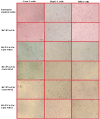Exploitation of cantaloupe peels for bacterial cellulose production and functionalization with green synthesized Copper oxide nanoparticles for diverse biological applications
- PMID: 36357532
- PMCID: PMC9649720
- DOI: 10.1038/s41598-022-23952-w
Exploitation of cantaloupe peels for bacterial cellulose production and functionalization with green synthesized Copper oxide nanoparticles for diverse biological applications
Abstract
The promising features of most bacterial celluloses (BC) promote the continuous mining for a cost-effective production approach toward wide and sustainable applications. Herein, cantaloupe peels (CP) were successfully implemented for sustainable BC production. Results indicated that the enzymatically hydrolyzed CP supported the maximum BC production of approximately 3.49 g/L when used as a sole fermentation media. The produced BC was fabricated with polyvinyl alcohol (PVA) and chitosan (Ch), and loaded with green synthesized copper oxide nanoparticles (CuO-NPs) to improve its biological activity. The novel composite showed an antimicrobial activity against several human pathogens such as Staphylococcus aureus, Streptococcus mutans, Salmonella typhimurium, Escherichia coli, and Pseudomonas fluorescens. Furthermore, the new composite revealed a significant in vitro anticancer activity against colon (Caco-2), hepatocellular (HepG-2), and breast (MDA) cancer cells, with low IC50 of 0.48, 0.27, and 0.33 mg/mL for the three cell lines, respectively. On the other hand, the new composite was remarkably safe for human skin fibroblast (HSF) with IC50 of 1.08 mg/mL. Interestingly, the composite membranes exhibited lethal effects against all stages of larval instar and pupal stage compared with the control. In this study, we first report the diverse potential applications of BC/PVA/Ch/CuO-NPs composites based on green synthesized CuO-NPs and sustainably produced BC membrane.
© 2022. The Author(s).
Conflict of interest statement
The authors declare no competing interests.
Figures














Similar articles
-
Green synthesis of copper oxide nanoparticles using Abutilon indicum leaves extract and their evaluation of antibacterial, anticancer in human A549 lung and MDA-MB-231 breast cancer cells.Food Chem Toxicol. 2022 Oct;168:113330. doi: 10.1016/j.fct.2022.113330. Epub 2022 Aug 1. Food Chem Toxicol. 2022. PMID: 35926645
-
Facile synthesis of Fe2O3, Fe2O3@CuO and WO3 nanoparticles: characterization, structure determination and evaluation of their biological activity.Sci Rep. 2024 Mar 13;14(1):6081. doi: 10.1038/s41598-024-55319-8. Sci Rep. 2024. PMID: 38480834 Free PMC article.
-
Fabrication of chitosan and Trianthema portulacastrum mediated copper oxide nanoparticles: Antimicrobial potential against MDR bacteria and biological efficacy for antioxidant, antidiabetic and photocatalytic activities.Int J Biol Macromol. 2023 Jul 1;242(Pt 3):124954. doi: 10.1016/j.ijbiomac.2023.124954. Epub 2023 May 19. Int J Biol Macromol. 2023. PMID: 37211075
-
Overview of bacterial cellulose composites: a multipurpose advanced material.Carbohydr Polym. 2013 Nov 6;98(2):1585-98. doi: 10.1016/j.carbpol.2013.08.018. Epub 2013 Aug 15. Carbohydr Polym. 2013. PMID: 24053844 Review.
-
Green and cost-effective biofabrication of copper oxide nanoparticles: Exploring antimicrobial and anticancer applications.Biotechnol Rep (Amst). 2024 Jan 12;41:e00828. doi: 10.1016/j.btre.2024.e00828. eCollection 2024 Mar. Biotechnol Rep (Amst). 2024. PMID: 38312482 Free PMC article. Review.
Cited by
-
Biogenic nanoparticles: pioneering a new era in breast cancer therapeutics-a comprehensive review.Discov Nano. 2024 Aug 3;19(1):121. doi: 10.1186/s11671-024-04072-y. Discov Nano. 2024. PMID: 39096427 Free PMC article. Review.
-
Production and characterization of bacterial cellulose synthesized by Enterobacter chuandaensis strain AEC using Phoenix dactylifera and Musa acuminata.Arch Microbiol. 2024 Oct 29;206(11):447. doi: 10.1007/s00203-024-04182-2. Arch Microbiol. 2024. PMID: 39470811
-
Anticancer activity of lactoferrin-coated biosynthesized selenium nanoparticles for combating different human cancer cells via mediating apoptotic effects.Sci Rep. 2023 Jun 13;13(1):9579. doi: 10.1038/s41598-023-36492-8. Sci Rep. 2023. Retraction in: Sci Rep. 2025 Mar 19;15(1):9451. doi: 10.1038/s41598-025-94145-4. PMID: 37311791 Free PMC article. Retracted.
-
Advances in the Production of Sustainable Bacterial Nanocellulose from Banana Leaves.Polymers (Basel). 2024 Apr 20;16(8):1157. doi: 10.3390/polym16081157. Polymers (Basel). 2024. PMID: 38675076 Free PMC article.
-
Advances in biomedical applications of bacterial cellulose: from synthesis mechanisms to commercial innovations.World J Microbiol Biotechnol. 2025 Apr 12;41(4):132. doi: 10.1007/s11274-025-04354-2. World J Microbiol Biotechnol. 2025. PMID: 40216641 Review.
References
-
- Picheth GF, et al. Bacterial cellulose in biomedical applications: A review. Int. J. Biol. Macromol. 2017;104:97–106. - PubMed
-
- Klemm D, Heublein B, Fink HP, Bohn A. Cellulose: Fascinating biopolymer and sustainable raw material. Angew. Chem. Int. Ed. 2005;44:3358–3393. - PubMed
-
- Güzel M, Akpınar Ö. Preparation and characterization of bacterial cellulose produced from fruit and vegetable peels by Komagataeibacter hansenii GA2016. Int. J. Biol. Macromol. 2020;162:1597–1604. - PubMed
-
- Jacek P, da Silva FAS, Dourado F, Bielecki S, Gama M. Optimization and characterization of bacterial nanocellulose produced by Komagataeibacter rhaeticus K3. Carbohyd. Polym. Technol. Appl. 2021;2:100022.
Publication types
MeSH terms
Substances
LinkOut - more resources
Full Text Sources
Miscellaneous

